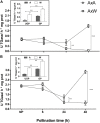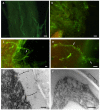Compatible and Incompatible Pollen-Styles Interaction in Pyrus communis L. Show Different Transglutaminase Features, Polyamine Pattern and Metabolomics Profiles
- PMID: 31249577
- PMCID: PMC6584118
- DOI: 10.3389/fpls.2019.00741
Compatible and Incompatible Pollen-Styles Interaction in Pyrus communis L. Show Different Transglutaminase Features, Polyamine Pattern and Metabolomics Profiles
Abstract
Pollen-stigma interaction is a highly selective process, which leads to compatible or incompatible pollination, in the latter case, affecting quantitative and qualitative aspects of productivity in species of agronomic interest. While the genes and the corresponding protein partners involved in this highly specific pollen-stigma recognition have been studied, providing important insights into pollen-stigma recognition in self-incompatible (SI), many other factors involved in the SI response are not understood yet. This work concerns the study of transglutaminase (TGase), polyamines (PAs) pattern and metabolomic profiles following the pollination of Pyrus communis L. pistils with compatible and SI pollen in order to deepen their possible involvement in the reproduction of plants. Immunolocalization, abundance and activity of TGase as well as the content of free, soluble-conjugated and insoluble-bound PAs have been investigated. 1H NMR-profiling coupled with multivariate data treatment (PCA and PLS-DA) allowed to compare, for the first time, the metabolic patterns of not-pollinated and pollinated styles. Results clearly indicate that during the SI response TGase activity increases, resulting in the accumulation of PAs conjugated to hydroxycinnamic acids and other small molecules. Metabolomic analysis showed a remarkable differences between pollinated and not-pollinated styles, where, except for glucose, all the other metabolites where less concentrated. Moreover, styles pollinated with compatible pollen showed the highest amount of sucrose than SI pollinated ones, which, in turn, contained highest amount of all the other metabolites, including aromatic compounds, such as flavonoids and a cynnamoil derivative.
Keywords: 1H NMR-metabolomics; Pyrus communis; polyamines; self-incompatibility; transglutaminase.
Figures







Similar articles
-
Compatible and self-incompatible pollination in Pyrus communis displays different polyamine levels and transglutaminase activity.Amino Acids. 2010 Feb;38(2):659-67. doi: 10.1007/s00726-009-0426-5. Epub 2009 Dec 18. Amino Acids. 2010. PMID: 20020163
-
Polyamines and transglutaminase activity are involved in compatible and self-incompatible pollination of Citrus grandis.Amino Acids. 2012 Feb;42(2-3):1025-35. doi: 10.1007/s00726-011-1017-9. Epub 2011 Aug 5. Amino Acids. 2012. PMID: 21818566
-
Temperature-Dependent Compatible and Incompatible Pollen-Style Interactions in Citrus clementina Hort. ex Tan. Show Different Transglutaminase Features and Polyamine Pattern.Front Plant Sci. 2020 Jul 8;11:1018. doi: 10.3389/fpls.2020.01018. eCollection 2020. Front Plant Sci. 2020. PMID: 32733518 Free PMC article.
-
Senescence and programmed cell death in plants: polyamine action mediated by transglutaminase.Front Plant Sci. 2014 Apr 7;5:120. doi: 10.3389/fpls.2014.00120. eCollection 2014. Front Plant Sci. 2014. PMID: 24778637 Free PMC article. Review.
-
Cytoskeleton, Transglutaminase and Gametophytic Self-Incompatibility in the Malinae (Rosaceae).Int J Mol Sci. 2019 Jan 8;20(1):209. doi: 10.3390/ijms20010209. Int J Mol Sci. 2019. PMID: 30626063 Free PMC article. Review.
Cited by
-
Leaves and Spiny Burs of Castanea Sativa from an Experimental Chestnut Grove: Metabolomic Analysis and Anti-Neuroinflammatory Activity.Metabolites. 2020 Oct 13;10(10):408. doi: 10.3390/metabo10100408. Metabolites. 2020. PMID: 33066101 Free PMC article.
-
Identification of Withania somnifera-Silybum marianum-Trigonella foenum-graecum Formulation as a Nutritional Supplement to Contrast Muscle Atrophy and Sarcopenia.Nutrients. 2020 Dec 26;13(1):49. doi: 10.3390/nu13010049. Nutrients. 2020. PMID: 33375229 Free PMC article.
-
Maize stigmas react differently to self- and cross-pollination and fungal invasion.Plant Physiol. 2024 Dec 2;196(4):3071-3090. doi: 10.1093/plphys/kiae536. Plant Physiol. 2024. PMID: 39371027 Free PMC article.
-
Editorial: Regulation of pollen tube growth, volume II.Front Plant Sci. 2023 Jul 11;14:1242416. doi: 10.3389/fpls.2023.1242416. eCollection 2023. Front Plant Sci. 2023. PMID: 37496862 Free PMC article. No abstract available.
-
Programmed Cell Death Reversal: Polyamines, Effectors of the U-Turn from the Program of Death in Helianthus tuberosus L.Int J Mol Sci. 2024 May 15;25(10):5386. doi: 10.3390/ijms25105386. Int J Mol Sci. 2024. PMID: 38791426 Free PMC article. Review.
References
LinkOut - more resources
Full Text Sources

